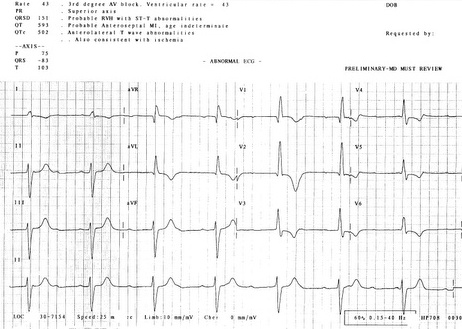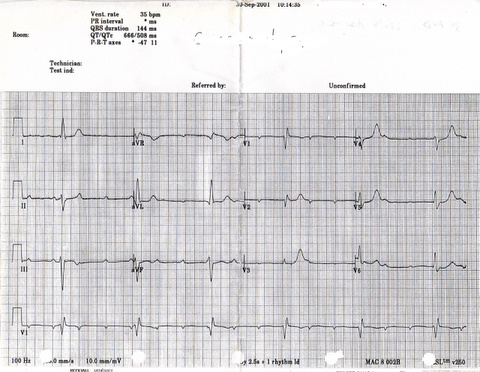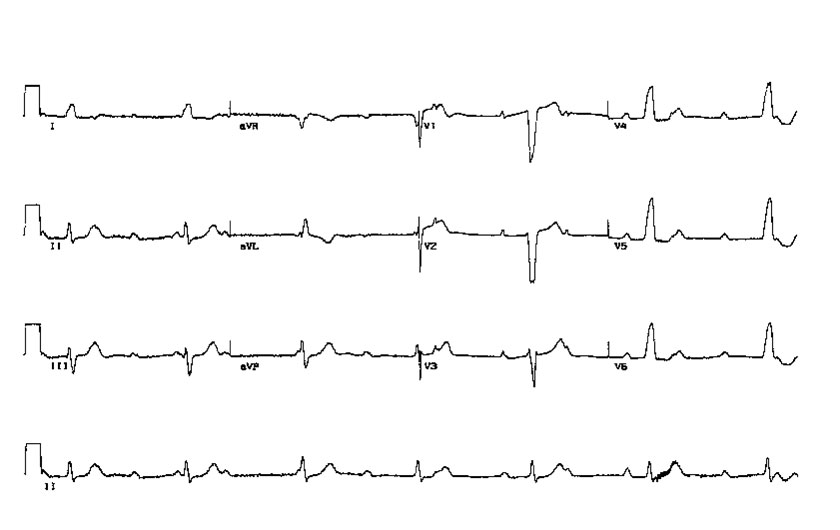Third degree AV block electrocardiogram
|
Third degree AV block Microchapters | |
|
Diagnosis | |
|---|---|
|
Treatment | |
|
Case Studies | |
|
Third degree AV block electrocardiogram On the Web | |
|
American Roentgen Ray Society Images of Third degree AV block electrocardiogram | |
|
Risk calculators and risk factors for Third degree AV block electrocardiogram | |
Editor-In-Chief: C. Michael Gibson, M.S., M.D. [1]; Associate Editor(s)-in-Chief: Cafer Zorkun, M.D., Ph.D. [2] Soroush Seifirad, M.D.[3]
Overview
ECG is the the main method of diagnosis and definition of the third degree AV block. Third-degree AV block is electrocardiographically characterized by regular R-R intervals, regular P-P intervals, and no apparent relationship between the P waves and QRS complexes. Generally, more P waves are present than QRS complexes because of the higher pace of atrial pacemaker system compared to the ventricular system (scape rhythm).
Electrocardiogram
Definition
Third-degree AV block is electrocardiographically characterized by:
- Regular R-R intervals
- Regular P-P intervals
- No apparent relationship between the P waves and QRS complexes
- Generally more P waves are present than QRS complexes because of the higher pace of atrial pacemaker system compared to the ventricular system (scape rhythm).
Please note that not every patient with AV dissociation does not fulfill criteria for complete heart block necessarily. For instance, patients with VT have AV dissociation, due to the ventricular rate being faster than the intrinsic sinus rate, which means they do not have complete heart block.
Complete heart block
- There is a complete failure of the supraventricular impulse to reach the ventricles.
- The atrial and the ventricular activities are independent of each other
- The block may be at the level of the AV node, the His bundle or the bundle branches
- If the block is in the main bundle branches, it is called bilateral bundle branch block
- If it involves the right bundle branch and two divisions of the left bundle, then it is called trifascicular block
- The atrial rate is faster than the ventricular rate
- The ventricular rhythm is maintained by either a junctional or an idioventricular pacemaker.
- The PP and RR intervals are regular, but the P waves bear no relation to the QRS complexes (i.e. the PR interval varies)
- In 30 to 40% of patients with complete AV block, ventriculophasic sinus arrhythmia can be demonstrated. In this case, there is a decrease in the PP interval in those PP intervals containing a QRS.
- When the underlying rhythm is atrial fibrillation, the presence of complete AV block is manifested by the regularity of the ventricular rhythm.
- In AV block, the atrial rate is faster than the ventricular rate, in AV dissociation the ventricular rate is faster than the atrial rate (likely due to automaticity of a subsidiary pacemaker).
- If the subsidiary pacemaker is above the His bundle, then the escape rhythm is of a narrow complex and is likely to be AV junctional in origin.
- If the subsidiary pacemaker is below the His bundle, then the escape rhythm is wide. Wide complexes can result from a junctional escape rhythm with a superimposed bundle branch block.
- The rate in complete AV block:
- AV junctional escape rhythms have a rate between 40 to 60 beats per minute, which may be increased by exercise or vagolytic agents
- Idioventricular rhythms have a rate of 30 to 40 beats per minute but may be as low as 20 and as high as 50, and the rate is not affected by exercise or vagolytic agents
- His bundle recordings:
- Allows determination of the site of block
- In chronic acquired complete AV block, most cases (50% to 60%) have block located distal to the His bundle, and the QRS complexes are wide.
- In acute heart block secondary to an inferior MI, infection, or drugs, the site of the block is usually proximal to the His bundle.
- In acute anterior MI, the site of the block is usually distal to the His bundle and reflects the fact that a large territory has been infarcted.
EKG Examples
Shown below is an EKG showing 3rd degree AV block. There is no relation between P waves and QRS complexes demonstrating third-degree AV block.

Copyleft image obtained courtesy of EKGpedia,http://en.EKGpedia.org/wiki/Main_Page
Shown below is an EKG showing 3rd degree AV block. There is no relation between P waves and QRS complexes demonstrating third-degree AV block.

Copyleft image obtained courtesy of EKGpedia,http://en.EKGpedia.org/wiki/Main_Page
Shown below is an EKG showing 3rd degree AV block. There is no relation between P waves and QRS complexes demonstrating third-degree AV block.

Copyleft image obtained courtesy of EKGpedia,http://en.EKGpedia.org/wiki/Main_Page
Shown below is an EKG showing 3rd degree AV block: There is no relation between P waves and QRS complexes

Copyleft image obtained courtesy of EKGpedia,http://en.EKGpedia.org/wiki/Main_Page
Shown below is an EKG depicting short lasting total AV block. P waves are present, but not followed by QRS complexes

Copyleft image obtained courtesy of EKGpedia,http://en.EKGpedia.org/wiki/Main_Page
Shown below is an EKG showing complete heart block. The recording shows one native ventricular complex followed by three paced venticular beats. Sinus P waves can be seen floating through and unrelated to the ventricular complexes. There is no evidence of conduction from the atrium.

Copyleft image obtained courtesy of EKGpedia,http://en.EKGpedia.org/wiki/Main_Page